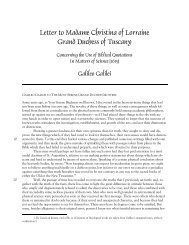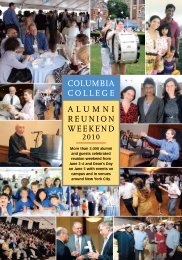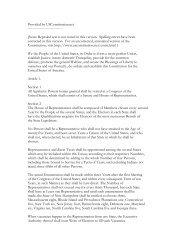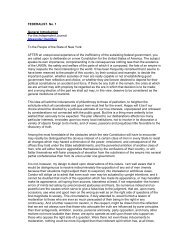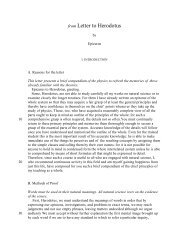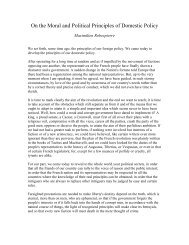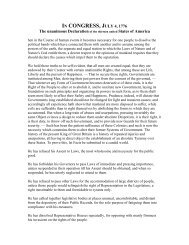spring 2012 columbia college women
spring 2012 columbia college women
spring 2012 columbia college women
Create successful ePaper yourself
Turn your PDF publications into a flip-book with our unique Google optimized e-Paper software.
COVER ARTICLECoeducation and EntrepreneurshipPHOTO: L. BrumbergAfew months ago, I saw a posting on the NYTech Meetup listserv from a fellow femaleentrepreneur. She asked if there were anyother expectant moms out there in the land of startupswho would like to meet up. The first personto respond said, essentially, that she would likelyfind very few. Mothers just were not able to devotethe time and energy needed to create a successfulstartup because of their responsibilities to theirchildren. Other entrepreneurs on the list, both maleand female, came out against this first response.They pointed out that, aside from pregnancy, therewas no reason why childcare responsibilities shouldbe delegated entirely to the mother and no reasonwhy mothers could not succeed as entrepreneurs.Being a mother who has embarked on anentrepreneurial venture of my own, I cheer on thesecond set of responses. I do this in the face ofdismal statistics that support an altogether oppositepicture. For example, only 28.7% of businesses areowned by <strong>women</strong>, and they tend to be less profitableand less enduring than those started by men (Source:Small Business Administration). Ironically, one ofthe reasons posited for this is that <strong>women</strong> often startpart-time businesses to stay in the work force andmaintain flexibility while they start their families.In my own industry, the legal profession, the statisticsare also not great. Although <strong>women</strong> make up about47.2% of law students, and 45.4% of associates atlaw firms, they make up only 19.5% of partners atlaw firms (Source: Catalyst: Women in Law in theU.S.).For my blind idealism, I blame coeducation. Giventhe success and accomplishments of other <strong>women</strong>in my class, who often beat out the men in academicsuccess and honors (our class valedictorian wasa woman), shouldn’t this same pattern of successcontinue in the business world? Indeed, withincreasing numbers of female entrepreneurs,including role models like Sheryl Sandberg, theCOO of Facebook, and Sarah Blakely, the inventorof Spanx and now a self-made billionaire, why not?To be honest, after <strong>college</strong>, I was surprised by thecontrast of how <strong>women</strong> are treated in the workforcecompared with how they are treated as students.This is something that coeducation did not prepareme for. At the first law firm where I worked, wherethere was only one female partner, I watched asthe male summer associates headed out to luncheach day with the male lawyers, while the femalesummer associates stayed in and worked as theyhad not been invited out to lunch. It seemed likethe male summer associates somehow innatelyknew how to network and meet the right mentorsfrom the start. At the second law firm where Iworked, many outstanding <strong>women</strong> attorneys whohad children did not stay. I can understand why– the juggle of childcare responsibilities and workresponsibilities is one of the hardest challenges Ihave faced since having my daughter, and it doesn’thelp that you must make certain choices that can“Although <strong>women</strong> make up about 47.2% of lawstudents, and 45.4% of associates at law firms,they make up only 19.5% of partners at law firms(Source: Catalyst: Women in Law in the U.S.).“affect your chances at partnership just as you startyour family.Still, compared to a generation ago, where, forexample, my mother was fired when she told heremployer that she was pregnant, at least there havebeen some efforts made to address the gender gapin the workforce. When, at that first law firm whereI worked, the female summer associates pointed outthe discrepancy in networking opportunities, theybegan to get invitations to lunch. Female attorneysat the firm made more of an effort to come to thesummer events, and at the end of the summer, thefirm promoted a part-time female associate to be itsfirst part-time partner. At the second law firm whereI worked, where part-time schedules were originallyA Woman’sChoice:Columbia orBarnardCOVER ARTICLEdiscretionary, the firm formalized the part-timepolicy and also allowed men to take paternity leave– which several male associates took.In reading the accounts of why Columbia Collegebecame co-ed, I find it fascinating that one of themain reasons was to attract the best and brightestpool of applicants. It only took about a hundredyears from when the trustees reluctantly agreedto form Barnard College to allow <strong>women</strong> to evenattend classes and earn a Columbia degree towhen they achieved the milestone of coeducation.I hope it does not take another 100 years for theentrepreneurial world to do the same.— Jane Chuang, CC ‘01, is a partner at Yim & Chuang LLP,a boutique law firm with practice areas in intellectual property andemployment law.I was born and raised in New York Cityand attended Dominican Academyon the Upper East Side, a <strong>college</strong>preparatory school with a strict focuson the <strong>college</strong> application process. Myfather was CC ‘79 and because of his history with Columbia, and my own research, Columbiawas my dream school. My best friend, however, decided to apply to Barnard College.PHOTO: L. BrumbergWhen my friend told me that she was applying to Barnard, but not Columbia, I was puzzled. Ourpreparatory school was an all-girls Catholic school and the thought of spending my <strong>college</strong>years at a <strong>women</strong>’s institution, even if it was across the street from a co-ed school, was notappealing. I needed a different environment from high school and welcomed Columbia’s coedstatus. On the contrary, my friend found Barnard’s focus on <strong>women</strong> to be comforting.My friend and I started our <strong>college</strong> careers at the same time and across the street from one another,but our experiences were very different. I enjoyed Columbia’s structure, housing options, and Coreclasses. She loved the nine ways of knowing, the comfort of living in all-female housing and the classofferings at Barnard. We eventually discovered that though both schools had something to offer, wehad each made the right choice for ourselves.— Zila Acosta, CC ’1112 13




